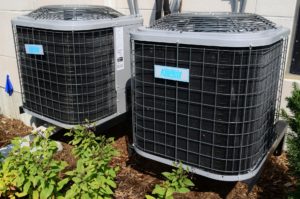Learning a New Language
Whether you’re new to the HVAC industry or simply trying to understand your home’s heating and cooling system, there’s a good chance you’re overwhelmed by all the acronyms and other jargon you’ve never heard of before. It can feel kind of like learning a new language, but no one gave you an HVAC glossary. but once you know what these terms mean, your overall understanding will go way up.
Let’s start with HVAC. If you’ve made it this far and still aren’t quite sure what HVAC means, don’t worry. HVAC stands for Heating, Ventilation, and Air Conditioning, so now you know the very first term!
We’ve put together this HVAC glossary of some of the most common words, phrases, and acronyms used in HVAC services, so you can feel confident when talking to a technician, embarking on any other HVAC-related project, or just expanding your own vocabulary.
The HVAC Glossary
AC (Alternating Current): an electric current that regularly reverses direction and changes its magnitude continuously with time. The opposite of direct current (DC).
Air Conditioner: a unit or system whose main purpose is to cool the air or maintain the temperature in a particular space.

BTU (British Thermal Unit): a measurement of the amount of heat required to raise or lower the temperature of one pound of water one degree Fahrenheit. The higher the BTU, the faster it will cool a space, so ACs with higher BTUs are good for larger spaces or cooling multiple rooms.
Burner: a device that facilitates the combustion of air and gas creating a flame.
CFM (Cubic Feet per Minute): a measurement of airflow volume.
Compressor: a pump that increases the pressure of refrigerant gas in a cooling system.
Condensate: the liquid and subsequent drainage from an AC. Part of the cooling process removes moisture from the air, and that moisture collects as the condensate.
Condenser Coil: it removes heat from the refrigerant in warm seasons, allowing the refrigerant to be converted from vapor to liquid and complete the refrigeration/cooling process.
Condenser Fan: it speeds up the air moving over the condenser coil, facilitating the removal of heat from the refrigerant.
DC (Direct Current): the electrical current that only flows in one direction. The opposite of alternating current (AC).
Dehumidifier: a device that removes moisture or humidity from the air. Less moisture in the air helps keep the air cool.
DOE (Department of Energy): the United States federal government department that oversees energy usage and other energy logistics.
Ductwork: the network of pipes, vents, and other spaces that allow air to circulate and move throughout and around a space.

EER (Energy Efficiency Rating): the ratio of output cooling energy (in BTU) to input electrical energy.
EPA (Environmental Protection Agency): the United States federal agency focused on protecting the environment and human health primarily through writing and enforcing regulations based on existing laws.
Evaporator Coil: an AC component that absorbs heat in the air in order to change the liquid refrigerant that flows through it into a vapor initiating the cooling process.
Filter: it prevents contaminants from entering the equipment and must be maintained or replaced at regular intervals. There is also a refrigeration system filter that acts as a strainer to remove dirt and undesired particles from the system.
Flue: a vent that removes the byproducts of combustion from a furnace.
Furnace: a device that facilitates the combustion of fuel and air to create heat and then circulates it through the home by means of a fan.
Heat Pump: a type of HVAC system that allows for both heating and cooling from only one device.
HSPF (Heating Seasonal Performance Factor): measures the efficiency of a residential heat pump system.
Humidifier: a device that adds moisture/humidity to the air.
Kilowatt: a measurement of energy equal to 1,000 watts.
NATE (North American Technician Excellence): a certification organization for HVAC and refrigeration technicians.
PSI (Pound per Square Inch): a unit of measurement for determining pressure.
PVC (Polyvinyl Chloride): a type of plastic commonly used in external pipes.
Refrigerant: the specific type of fluid used in ACs, refrigerators, and heat pumps to transfer heat into or out of interior space.
SEER (Seasonal Energy Efficiency Ratio): the cooling output during a typical cooling season divided by the total electric energy input during the same period.
Single Speed: a type of motor that only has a one-speed setting, so it runs until the room or space has cooled to the desired temperature and then shuts off.
Split System: an outdoor unit combined with an indoor unit (as opposed to a package unit), generally providing more efficiency and configuration options.
Thermostat: a device inside your home or other space that allows you to control the output of your HVAC system like temperature and turning the fan, AC, or heat on/off.

Two Speed: a type of motor that has a high and low-speed setting allowing it to cycle between the two for better AC efficiency since it doesn’t use as much energy when in the lower setting.
Variable Speed: a type of motor similar to a two-speed except it has multiple speed settings allowing for maximum AC efficiency and much more precise performance control.
Ventilation: the process of moving air in and out of a particular indoor space.
Zoning: a system that divides a home, office, or space into different regions in order to better control the temperature and effectiveness of a heating and cooling system.
Putting Your New Knowledge to Use
Now that you’ve made it to the end of this HVAC glossary, you should feel like a pro! With all this new information, you can better understand your own HVAC system and how to talk to a technician. Don’t forget, you can always give TemperaturePro a call and our trained professionals will help repair, install, or tune up your system.






